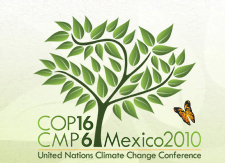Yesterday some 15,000 delegates, business leaders, activists and journalists gathered in Cancun to kick off the UN Framework Convention on Climate Change’s 16th meeting of the Conference of the Parties (COP 16). And already the UNFCCC has some good news to report: 400 major companies including Coca-Cola, Pepsico, Unilever and Walmart have promised to not use hydrofluorocarbons, a potent greenhouse gas used as a refrigerant, in new equipment after 2015. Although this is only a small first step, it is significant. Phasing out HFCs would provide 8 percent of the GHG reductions needed by midcentury to avoid the worst effects of climate change.
This is a promising opening to COP 16, especially in light of recent history. International negotiators have struggled to make progress in protecting the climate since the disappointing conclusion of the Copenhagen conference. Yet, as the progress on HFC reductions indicate, there are a few good reasons to hope that this year’s summit may produce a more tangible, positive outcome than the last.
Mexican leadership
COP 16 will benefit from the strong leadership of a developing country that is committed and engaged in the battle against climate change. In the run up to the conference, Mexican diplomats have been shuttling around the globe in search of issues where detailed progress can be made in Cancun. These efforts helped the UNFCCC craft a plan for the conference focused on securing agreement in financing for adaptation, sharing information on agriculture and technology, and setting rules for the reduced deforestation program, commonly referred to as REDD+.
Only weeks ago, it seemed likely that little more than an agreement on REDD+ was possible in Cancun. Now President Felipe Calderon of Mexico, who Washington Post’s William Booth refers to as “a climate wonk,” has announced that he will advocate for a “third way” in the climate negotiations. His developing country will make, as Booth describes it, “commitments to serious, verifiable reductions in greenhouse gases in exchange for billions in aid and technology transfers from big polluters such as the United States and European Union.” This could effectively defuse the superpower standoff between the US, which has demanded better monitoring of developing country commitments, and China, which wants more money, technology and emission reductions from rich nations.
“We would like to prove that a developing country can mitigate and adapt to climate change without hurting the economy,” Fernando Tudela, Calderon’s deputy secretary of planning and environmental policy explained. “We want to prove that in Mexico.”
The China challenge
Another encouraging trend is the reported increase in China’s climate cooperation. Meetings of the countries’ negotiators over the past months seem to have reduced the tensions between China, the world’s largest carbon dioxide emitter, and the US, which is the world’s richest nation and second biggest carbon polluter. “My sense is we have made progress,” said Jonathan Pershing, the leader of the US delegation in Cancun.
Statements by his Chinese counterpart Xie Zhenhua about the country’s new-found support for international emissions monitoring suggest Pershing may be right. Lamenting the bad press China got for its international climate policies — in spite of its ambitious domestic programs — Xie said, “if we make everything public and transparent, [the media] would have no reason to do that anymore, even if they wanted to. So for this reason, China is willing to be transparent.
“But,” Xie cautioned, “we want to get the details clear and principles decided.” And the details are what has consistently prevented the US, China, and the rest of the world from reaching a binding agreement.
Michael Levi of the Council on Foreign Relations (CFR) offers a novel approach to dealing with Chinese demands in Cancun: “Focus on everyone but China.” That way, he explains, China could no longer hide behind its less wealthy, less dirty partners in the Basic negotiating bloc. Levi says the US should give Brazil, South Africa, and India what they want from the negotiations and work with the EU to convince China to accept emissions restrictions and better monitoring.
Beyond Kyoto
And cleaning up China is a difficult but necessary step the international community must take if it hopes to halt climate change. As the chief economist of the International Energy Agency recently pointed out, if the EU were to increase its planned emissions cuts between now and 2020 from its current commitment of 20 percent to its aspirational goal of 30 percent, that reduction would only be “roughly equal China’s two-week gas output.” That’s why it’s important for negotiators in Cancun to move beyond the ineffective and soon-to-be expiring Kyoto Protocol and work to strengthen the accords the US helped force the Chinese to agree to in Copenhagen.
“The Kyoto Protocol was legally binding, yet Canada has grossly violated it without penalty; China, meanwhile, has technically adhered to the protocol, but only because it required nothing of Beijing,” Levi of CFR explains. “There is no reason to assume that a wise political deal cannot be more effective than an unambitious but legally binding one.”
In the wake of the Wikileaks diplomatic cable dump, US and Mexican delegates will have a lot of egos soothe to achieve the political deal Levi envisions. But negotiators would do well to remember that politics are easier to change than physics. “The atmosphere is indifferent to the sovereignty of states,” Mexico’s Calderon said in his keynote speech at the opening of the COP 16. “It would be a tragedy if our inability to see beyond our personal interests, our group or national interests makes us fail.”
